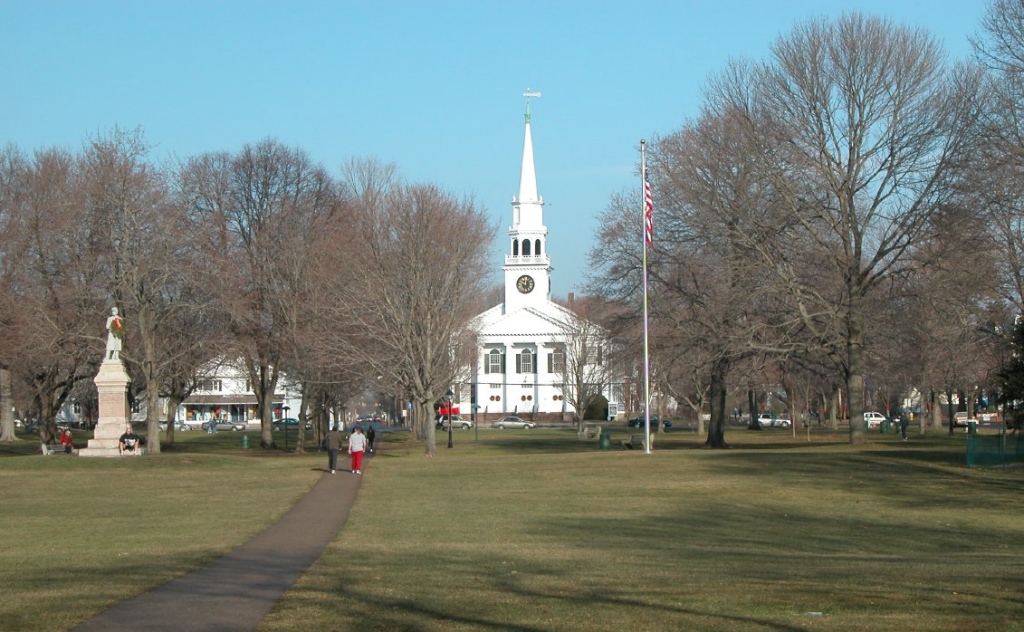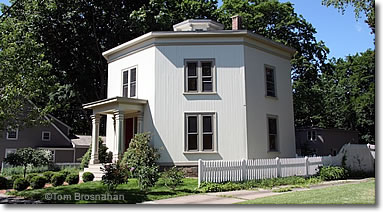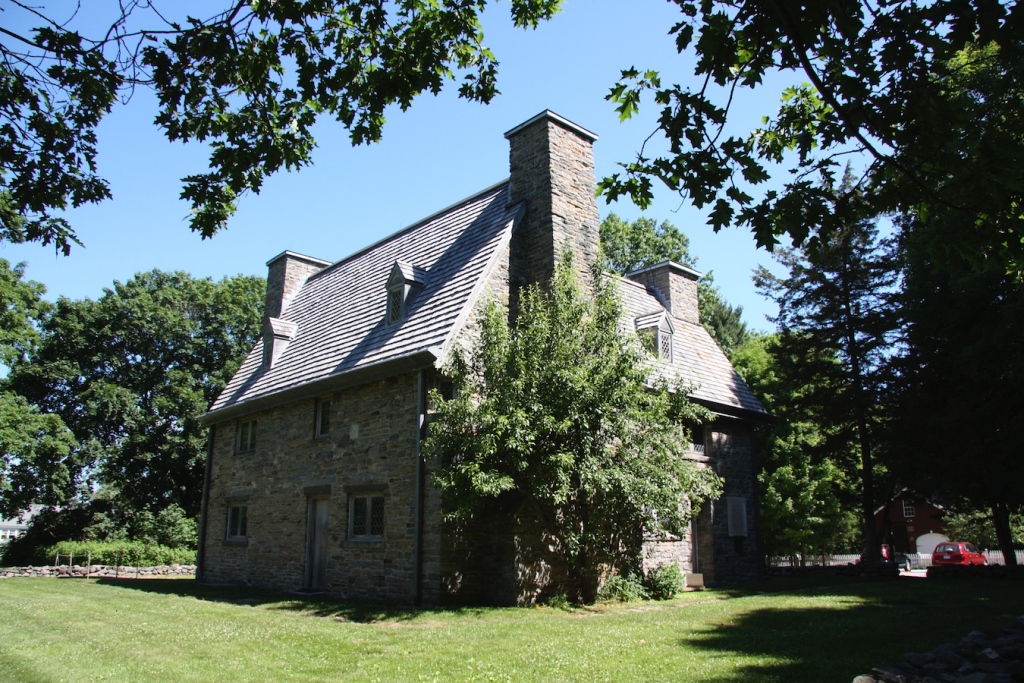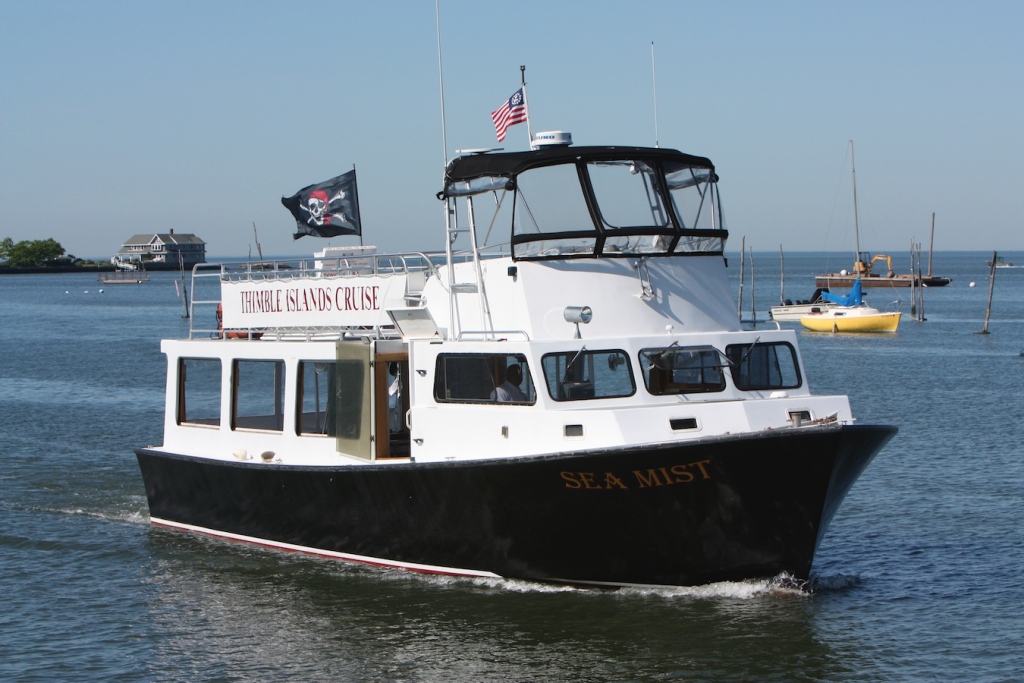Guilford CT Travel Guide
Among the prettiest and most dignified towns along the Connecticut shoreline, Guilford has an excellent variety of architectural styles and one of the finest town greens in New England.

Guilford Town Green
About Guilford
Guilford, Connecticut is a beautiful, historic town on the Connecticut shoreline that's easy to visit whether by car or train, and well worth the stop (map).
Unlike New Haven, Mystic or Ledyard (with its casinos), Guilford has no "headline" attraction to draw the crowds, which is one of the things that makes it so pleasant to visit: you'll see lots of natural and architectural beauty, but no tourist buses.
Guilford's architectural distinction started in 1639, when English colonists arrived and built a stately stone house for their leader, the Reverend Henry Whitfield. The house, the oldest house in Connecticut, still exists and is now open as a museum.
You can visit several other historic houses, but just walking several of the town's historic streets reveals numerous fine homes in a variety of architectural styles from the town's nearly four centuries of history.

Hexagonal house in Guilford, Connecticut.
Shops, cafes and restaurants near the town green provide sustinence and browsing opportunities.
If you have your own transportation, find your way to Stony Creek in neighboring Branford and hop aboard a boat for a delightful cruise of the aptly-named Thimble Islands.
The historic center of Guilford is just a mile or so south of I-95 Exit 57 on CT Route 77 (map). You can also easily reach Guilford by Amtrak train or Shore Line East train.
What to See & Do
Visitor Information Center
The Guilford Preservation Alliance operates the Guilford Visitor Information Center at 32 Church Street, next to the Community Center, is staffed by volunteers ready to answer your questions and provide brochures on attractions, arts, dining, entertainment, museums, shopping and tours. It's open Wednesday through Sunday, May through October, 10am to 4pm. More...

Guilford Preservation Alliance Information Kiosk...
Walking Tours
Historic Guilford organizes good Historic Walking Tours and Historic Architectural Walking Tours of this beautiful town founded in 1639. I can testify myself to Guilford's fascinating past, and its wonderful quality and variety of domestic and civic architecture. More...
Guilford Town Green
The historic town green at the center of Guilford is the first place to visit (map).
The broad expanse of lawn, surrounded by shade trees and decorated with historic monuments, is also the locus for summer concerts and fairs, and Guilford High School's graduation ceremonies.
From the green, you can walk to most of these other sights:
Henry Whitfield State Museum
The oldest house in Connecticut—in fact, the oldest stone house in all New England—is Guilford's main historic site and well worth a look. The house, now called the Henry Whitfield State Museum (open Wednesday to Sunday) is only a 7- to 10-minute walk south of the Guilford town green at 248 Old Whitfield Street, toward the train station (map).

The oldest house in Connecticut (1639).
The English Puritan founders of Guilford, Connecticut arrived here in the summer of 1639 and immediately began building thatched-roof log cabins for themselves.
For their esteemed leader, Reverend Henry Whitfield, however, they built a fine stone residence.
The solid structure could also be used, along with three other stone houses built for leaders, as protection against hostile raids, should they occur.
The thatched cottages and the other three stone houses of early Guilford are long gone, but Reverend Whitfield's house survives.
You can get a glimpse of what life was like for the settlers nearly four centuries ago by touring the house, which is right next door to Guilford's Visitor Center and tourist information office.
Hyland House
The Dorothy Whitfield Historic Society has preserved the historic colonial Hyland House (1690-1710) at 84 Boston Street (Tel: 203-453-9477), just a short walk from Guilford town green, to give visitors a look at what life was like in Guilford CT over three centuries ago. More...
Thomas Griswold House
Preserved by the Guilford Keeping Society, the Griswold House (c. 1774) at 171 Boston Street includes the saltbox house itself, its barn, blacksmith shop and other outbuildings. More...
Historic Domestic Architecture
Walk around the town green, and also along Broad Street and Fair Street (map), for a quick look at Guilford's wonderful variety of domestic architecture (ie, houses) from all four centuries of its history.
Vineyards & Wineries
Guilford has several good wineries, including Bishop's Orchards Winery right in Guilford, and Chamard Vineyards in neighboring Clinton CT. More...
Thimble Islands
A short drive from Guilford along scenic CT Route 146 brings you to Stony Creek (map) in neighboring Branford CT, where you can board a boat for a delightful cruise among the Thimble Islands.Follow scenic CT Route 146 several miles west to Stony Creek (map) in neighboring Branford CT to board a boat for a delightful cruise among the Connecticut shoreline's Thimble Islands.

The Sea Mist takes voyagers on a cruise of the Thimble Islands.
The aptly-named archipelago is right off the coast, and makes for a good maritime break from sightseeing on land—especially for the kids.
Dutch explorer Adriaen Block was the first to document the islands in 1614. Captain Kidd, the famous pirate, showed up here not too long afterwards. Bootleggers and smugglers probably used the islands as transit points. Today all is tranquil, and the islands are just for fun.
The air is clear and cool, the waters usually calm (this is Long Island Sound, not the open ocean), the islands unusual: some are barely large enough to hold one house, others may be home to several families, and the smallest are just rookeries for sea birds.
Normal daytime cruises take less than an hour. There are specialty cruises (wine and cheese, sunset, etc.) as well.
For lunch or supper, try Stony Creek Market famous for its pizzas and sandwiches.
Transportation
Interstate 95 passes through Guilford (Exits 57, 58 & 59) about a mile north of the historic center, reached by heading south on CT Route 77 from I-95 Exit 58.
US Route 1 passes through Guilford south of I-95, connecting the town centers along the Connecticut shoreline.
Amtrak trains stop at Guilford station, connecting Guilford with New York City, New Haven, Old Saybrook, New London, Westerly RI, Providence RI and Boston MA. More...
Shore Line East trains connect New Haven and New London on the Connecticut shoreline, stopping at most towns along the way, including Guilford. More...
Guilford's railroad station is less than a mile southeast of the town green along Whitfield and Old Whitfield St (map), and only 3/10 of a mile from the Henry Whitfield State Museum ("Oldest House in Connecticut").
Where to Stay
Here's a Hotel Map with Prices to help you find a place for the night.
History of Guilford
Guilford, Connecticut was founded in the summer of 1639 after a group of Puritans arrived in the colony of Quinnipiac (now New Haven) from England.
Under the leadership of Rev. Henry Whitfield, they negotiated with Shaumpishuh, sachem of the local people, for use of a tract of land east of Quinnipiac and west of another colony, Saybrook. The name of the place was Menuncatuck, which later became Guilford.
The land was a short distance inland from the waters of Long Island Sound, across the broad band of salt marsh that guards the coast here.
The Guilford colonists built modest log houses with thatched roofs for themselves, but a fine stone house for Rev. Whitfield. The Whitfield house, finished in the year of their arrival, is the oldest house in Connecticut and the oldest stone house in New England.
It's preserved and open to the public as the Henry Whitfield State Museum.
The Guilford colony prospered, with rich fields and orchards supplemented by food and income from the sea. The modest thatched homes around the town green were replaced by fine colonial, and then Federal and later style houses.
The 19th century saw increases in industry, including shipbuilding, carriage-making, iron foundries, granite quarries, and canning of food.
The coming of the railroad gave another boost to Guilford's economy, and the line linking New Haven and New York City with New London, Providence and Boston still goes right by Guilford. Victorian families would escape the big cities and come to Guilford for summer vacations in its natural beauty and serene atmosphere.
In the 20th century, the construction of the Connecticut Turnpike (now Interstate 95) brought Guilford into even closer contact with other Connecticut shoreline towns.
Guilford has now settled down to a dignified life as one of the prettiest and most dignified towns along the shoreline, attracting weekened, seasonal and even permanent residents from as far away as New York City.
Historic Guilford organizes good Historic Walking Tours and Historic Architectural Walking Tours of this beautiful town founded in 1639. I can testify myself to Guilford's fascinating past, and its wonderful quality and variety of domestic and civic architecture. More...
